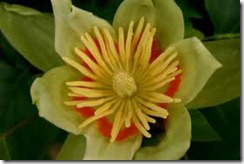Tulip poplars (Liriodendron tulipifera), so called for their greenish-yellow and orange cup-shaped flowers, are not poplars, but members of the magnolia family. Tulip poplars stand like columns in their native hardwood forests. Poplar trees develop soft wood that can be cut and shaped for furniture, toys and instruments. For this reason, the trees’ timber value overshadows any ornamental value they provide as landscape plants. Few cultivars exist and they are hard to find. Tulip poplars tend to develop several minor disease and insect problems.
Size and Growth
-
Tulip poplars grow up to 80 feet tall and 40 feet wide in urban settings and over 100 feet tall in natural settings — much too tall for residential sites. Young trees display upright, pyramidal growth. Mature trees develop irregular or spreading growth. Their central leader and upper branches ascend to such great heights that the limbs tend to break during wind, lightning and ice storms.
Flowering
-
Tulip poplars less than 15 years old typically do not flower. Trees that do flower only produce a smattering of blooms in late May to early June. The flowers, which grow upright at the top of the tree, frequently go unnoticed.
Adaptation
-
Tulip poplars prefer the moist, loose-textured soils found in the forest and fields of the eastern U.S. The trees do not grow well outside USDA Hardiness Zones 4 through 9, especially dry climates. Leaf yellowing and leaf drop occurs as early as July in response to drought.
Considerations
-
Tulip polar stands require thinning every ten years due to their rapid growth. Aphids infest the trees and secrete a honeydew substance that causes a buildup of sooty mold on the leaves. Leaf spot fungal infections present flecks that coalesce into larger tan or white spots with dark margins. Affected leaves turn yellow and drop from the tree. Prevent pest and disease damage with proper sanitation. Prune infected poplar branches and rake leaves in fall. Water trees during periods of drought and apply mulch to conserve water. Apply fertilizer to promote health.


Deprecated: strpos(): Passing null to parameter #1 ($haystack) of type string is deprecated in /home/agriviek8Qv/agriviet.net/public_html/wp-includes/comment-template.php on line 2522